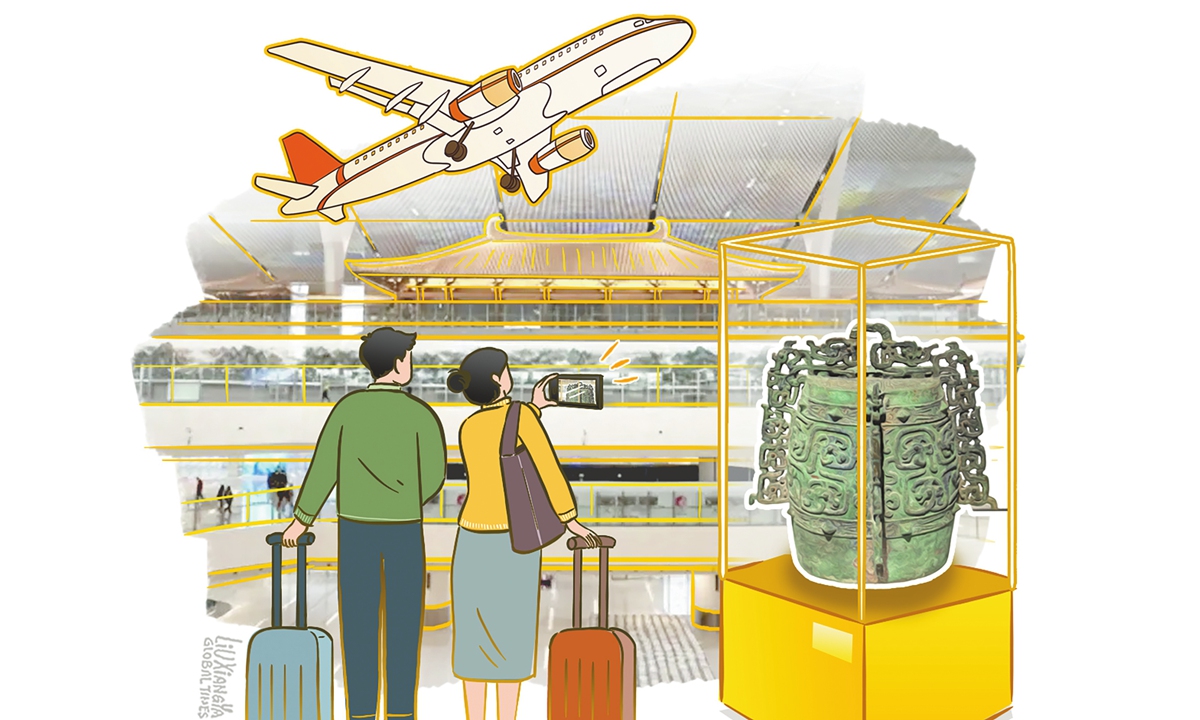
Illustration: Liu Xiangya/ GT
The
mk Xi'an Xianyang International Airport in Northwest China's Shaanxi Province, known for world-famous relics such as the Terracotta Army, is no longer merely a transportation space for tourists since it introduced the world's first in-terminal museum showcasing local archaeological treasures on Thursday. This bold initiative redefines the boundaries of both museum spaces and transportation hubs, heralding a new chapter in cultural accessibility and public engagement.
With the visa-free transit policy extending the permitted stay for eligible foreign travelers to 240 hours, the number of foreigners entering through Xi'an Port in 2024 exceeded 126,000 - a remarkable year-on-year increase of 140 percent. As an increasing number of tourists depart from this ancient city and the country via the airport, the museum offers a captivating final destination for them to explore further relics that embody the essence of traditional Chinese culture. This move allows visitors to cherish these memories as souvenirs accompanying them on their long journey home.
Meanwhile, for many travelers who have just arrived in Xi'an or even in China for the first time, the museum may be their first encounter with Chinese history and the city's culture, thus leaving a lasting impression and fostering cross-cultural understanding.
Covering a total area of 6,400 square meters, the museum houses artifacts unearthed during the airport's construction, including the star exhibit - the national first-class cultural relic "Qin Duke Bo," a large percussion instrument from the Spring and Autumn Period (770BC-476BC). Inscribed with 135 characters, it represents a stirring "history of the Qin people's founding endeavors."
Alongside the extraordinary collections, the architectural complex of the museum is designed in a traditional Chinese style using modern materials, blending history, culture and innovation, according to the Guangming Daily.
The concept of placing a museum in an airport challenges the traditional notion of what a museum is and where it belongs. For centuries, museums were seen as static institutions confined to grand buildings in urban centers, visited primarily by those who actively sought cultural experiences. However, the last few decades have witnessed a seismic shift in how museums interact with the public. To remain relevant in an increasingly fast-paced and decentralized world, museums have embraced a "beyond-the-walls" philosophy, breaking spatial and participatory boundaries.
One of the key issues that museums should carefully consider is how to effectively utilize public spaces, Chen Lüsheng, a renowned museologist and curator of the Museum of University of Science and Technology of China, told the Global Times.
This trend has seen exhibitions move into schools, parks and communities, where cultural artifacts can be directly experienced by diverse audiences. By bringing museums to where people already are, rather than waiting for them to come, these initiatives democratize access to culture and traditions.
The museum at the T5 terminal of the Xianyang International Airport takes this evolution a step further, embedding a museum within one of busiest crossroads in modern society. Airports, with their immense daily foot traffic and diverse international travelers, present an unparalleled opportunity to engage a broad and varied public.
Travelers often spend hours waiting for flights, navigating layovers, or enduring delays. In these moments, they are a captive audience, actively seeking ways to pass the time. A museum in a space that offers more than just a distraction; it transforms idle time into an opportunity for cultural enrichment. The terminal museum, with its treasures like the "Qin Duke Bo," not only introduces visitors to the rich history of Xi'an - a city renowned as the cradle of Chinese civilization - but also provides an immersive experience that combines education and leisure.
This approach suggests a broader vision for museums in the future. They can exist wherever people gather, whether in airports, shopping malls, or even train stations. Cultural institutions no longer need to be destinations in and of themselves; instead, they can seamlessly integrate into the fabric of daily life, making history and art a natural part of everyday experiences.
This model addresses key challenges facing museums today, including accessibility, audience engagement and cultural outreach, Chen noted.
Airports have long been seen as mere transit points - functional spaces designed to move people from one place to another. However, as modern cities evolve and lifestyles change, the role of airports is also transforming. Increasingly, they are becoming complex ecosystems that blend travel with commerce, entertainment, and now, culture.
This concept of "functional fusion" - where spaces traditionally designed for one purpose take on additional cultural, educational or social roles - has far-reaching implications. Airports, train stations and even highways can become sites of cultural engagement, enriching public spaces and redefining how visitors experience cities.
Zhu Bingren, a master copper sculptor and Chinese national intangible cultural heritage inheritor of copper art, created a copper screen featuring a stunning landscape that harmoniously integrates the natural beauty of Wenzhou with the landmarks along the railway for the bustling hall of the Wenzhou North Railway Station in September 2024. Before that, the artist also opened several copper art exhibition halls at other transportation hubs such as railway stations and airports across China.
"The construction of the high-speed rail needs culture and art to bring warmth to the iron giant," Zhu told the Global Times.
While the idea of museums without walls is not entirely new, embedding a museum within an airport - a space emblematic of modern mobility and globalization - represents a bold and innovative step forward.
The author is a reporter with the Global Times.
[email protected]


 Chinese U20 national football team ignites hope despite heartbreaking defeat
Chinese U20 national football team ignites hope despite heartbreaking defeat Chinese athletes complete clean sweep of ski mountaineering at Harbin 2025
Chinese athletes complete clean sweep of ski mountaineering at Harbin 2025 Global solution to climate change needs efforts of all, including the US
Global solution to climate change needs efforts of all, including the US Chinese firms’ performance reflects resilience in the face of US tariff uncertainty
Chinese firms’ performance reflects resilience in the face of US tariff uncertainty